The Acer Predator Triton 500 Laptop Review: Going Thin with GeForce RTX 2080
by Brett Howse on April 25, 2019 8:00 AM ESTSystem Performance
Acer offers just a single processor across the Predator Triton 500 lineup. Intel’s Core i7-8750H is a six-core processor with a 2.2 GHz base, and 4.1 GHz boost frequency. This is a Coffee Lake processor, and is the lowest tier of the hex-core i7 models available. But with six cores and twelve threads, it still offers a significant amount of performance in a 45-Watt envelope.
The base tier of this laptop ships with 16 GB of DDR4, and the review unit comes with the full 32 GB allotment. There’s two SODIMM slots if RAM upgrades are something you are into. For storage, Acer offers either 512 GB of NVMe SSD storage, or two 512 GB NVMe drives in RAID 0. I’m personally not a big fan of the RAID 0 thing, since a single larger drive would likely offer better real-world performance at less cost, but it tends to be a thing in gaming laptops unfortunately.
To test system performance, the Acer Predator Triton 500 was run through our laptop workloads. Graph comparisons are against other GTX 1070 and GTX 1080 laptops we’ve seen over the last couple of years, but if you’d like to compare the Triton 500 to any other laptop we’ve reviewed, please check out our online bench database.
PCMark




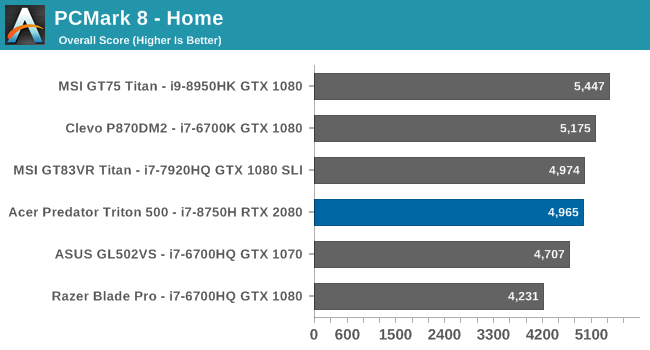

UL’s PCMark is a comprehensive system test, offering multiple workloads to stress various components. Since we’ve not had a lot of gaming laptops to test since PCMark 10 was released, PCMark 8 is also included in these results. PCMark 8 Creative wasn’t included due to an error on one of the tests. The hex-core CPU doesn’t do a lot for PCMark, which focuses more on office tasks and the like, but the Predator Triton 500 still performs well.
Cinebench

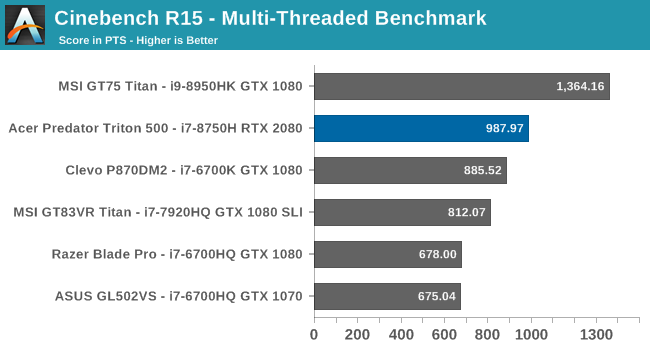
Recently Cinebench R20 was release, and we’ll be transitioning to it once we get some more data, but for this review R15 was used. The Core i7-8750H does well in the single-threaded test, and the extra cores provide a nice boost in the multi-threaded results. It can’t hang with the Core i9-8950HK in the GT75 Titan, but that device does have an 800 MHz frequency advantage.
x264
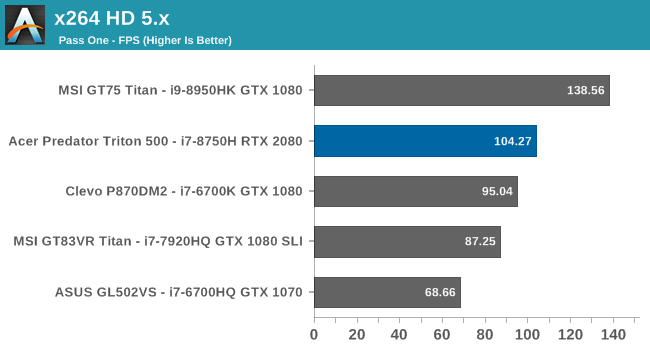
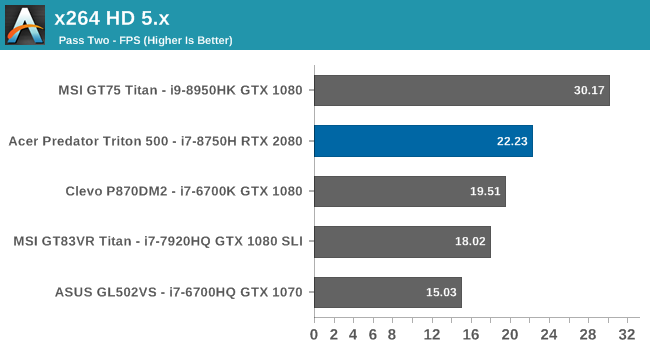
The x264 test converts a video using CPU, and is likes more cores and higher frequencies. The extra cores give the Triton 500 a speed boost over the quad-core models that used to ship in the 45-Watt range, but once again the Core i9 really stretches its legs here.
Web Tests
Unlike most benchmarks, web benchmarks are influenced heavily by the underlying browser, and since browsers are updated all of the time, performance can change over time as well. Normally it goes up, but we’ve standardized on Microsoft Edge since Windows 10 launched, and Edge performance has taken a step backwards over the last couple of updates.
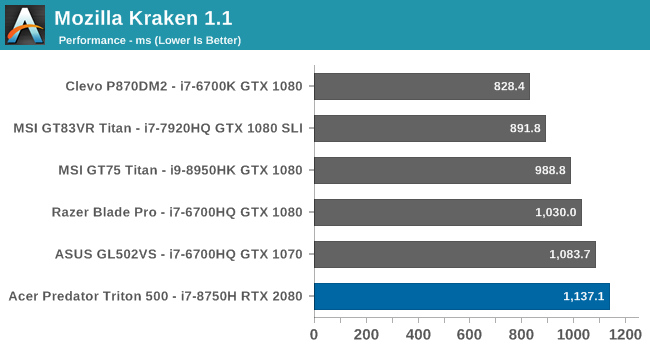
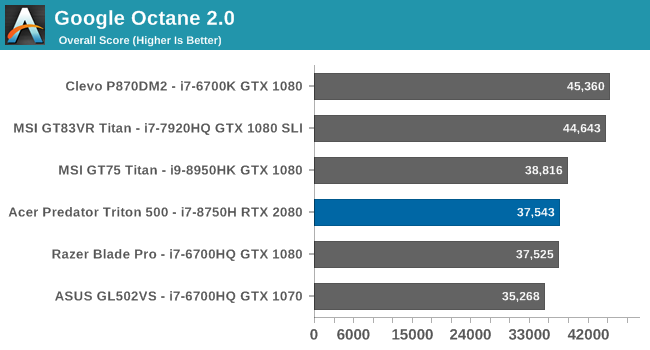
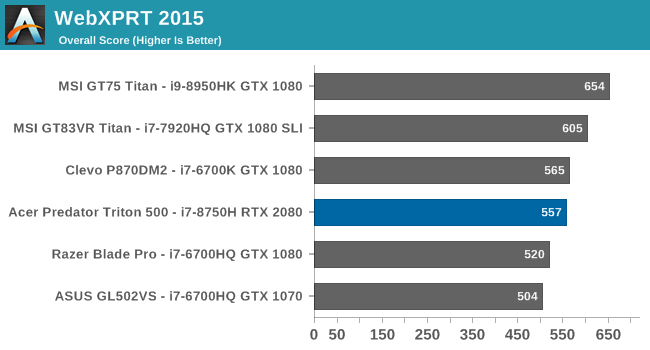

Performance is still good, but there does seem to be a regression in Edge on some of these tests. When we move to the Chromium based Edge, we’ll likely take that opportunity to move into some new, more modern, web tests.
CPU Conclusion
Acer’s choice to go with the Core i7-8750H is a good one. It lets them compete on price, and the hex-core CPU offers great performance. It can’t quite keep up with the Core i9-8950HK, but it still offers stout performance in the 45-Watt class.
Storage Performance
Acer couples two NVMe PCIe 3.0 x 4 SSDs together in the highest model in their Triton 500 range, which is what we have to review. RAID 0 doesn’t really offer much of a benefit for most people on most tasks, although there’s little doubt it does boost storage benchmark results, which is likely why so many gaming laptops ship this way.
In sequential tests, the RAID 0 pretty much maxes out the PCIe link for read, although for write there’s no benefit of the RAID. It also doesn’t likely help much with the random results either, which is why the extra risk of running RAID 0 doesn’t really outweigh the added costs of having to purchase two drives. One single 1 TB quality drive would almost certainly outperform the 2 x 512 we have here.



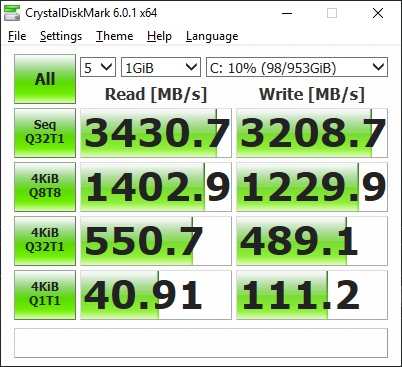








46 Comments
View All Comments
Spunjji - Friday, April 26, 2019 - link
You're looking at something similar to me; only I'm not interested in the 2080 specifically as it's comically overpriced. I'd prefer a 2060 and enough thermal headroom to get it running at something close to actual desktop 2060 performance.nVidia really dropped a bollock this generation. After having rough performance parity between desktop and notebook with Pascal (Max-Q snake oil excluded) they quietly dropped it for Turing but kept the same naming convention. The performance disparity is egregious now, while prices have been out of control since Maxwell.
vicbee - Thursday, April 25, 2019 - link
Guess there are enough 16 to 25 year olds with $3k+ to spend on gaming laptops who love the bling. Beyond my understanding.Junz - Thursday, April 25, 2019 - link
I have the triton 500 and it doesn't have Optimus but there is and option to turn on Mshybrid in the BIOS and in the predator sense software settings gear wheel there is an option for dgpu only which if turned off I believe does the same thing.Also would never have bought the laptop at full price but managed to get the $2500 model for $2100 tax free from Best Buy.
Brett Howse - Thursday, April 25, 2019 - link
Hi Junz. Thanks for the tip. I see there is an option for Optimus so I've enabled it (disabling G-SYNC) and updated the article text. Re-running the battery life tests as well.Junz - Friday, April 26, 2019 - link
No problem. I feel like I get around 6-7 hours from a full charge while running something like dev-c++ and music/YouTube playing in the background. I can't wait to see your results though.PeachNCream - Friday, April 26, 2019 - link
Wish Acer would just use Intel branded network adapters in these systems. It feels like a frisking rather than a premium experience to buy at the highest end, but get saddled with Killer NICs.Brett Howse - Friday, April 26, 2019 - link
Killer uses Intel as their base adapter now and this laptop uses the 1550 Killer which is based on the 9260 IntelPeachNCream - Friday, April 26, 2019 - link
Yes, I'd heard that was the case. The trouble is that as with any rebranding effort, a company that purchases and resells has to perform some sort of markup in order to turn over a profit. That's where Rivet Networks (RN) sits, as a middleman business between Intel and the OEMs. Normally these in-between companies offer the prospect of added value, but RN's offerings of additional software don't generally improve on vanilla Intel adapters by offering useful features. A lot of us with networking backgrounds and people that have picked up the basics of how packets find their way to the end destination and back remain unconvinced that software prioritization at the NIC makes a measurable difference and there is a dearth of supporting numbers to prove otherwise. Meanwhile features like ethernet adapter teaming (market speak - DoubleShot) are not new features and have little reason to be implemented at an endpoint node that mainly performs consumer computing. Rivet has worked at stabilizing their software so at least that problem is not as pronounced as it was in the past and the switch to buying Intel was probably a good move from a driver standpoint, yet Killer NICs selling points appear to prey on a lack of knowledge and have that snake oil flavor. I'd hope Rivet finds a different, more meaningful way to add value so they can earn the premium level the company is hoping to achieve. Before that can happen, something fundamental needs to change about what they're offering and how they're offering it....or someone needs to post some numbers that put the proof in the pudding about the claims they're making.Hrel - Saturday, April 27, 2019 - link
Acer has known reliability issues, what I'd really like to see is stress testing, since you are apparently gonna keep advertising their products. I've never had an Acer anything last more than 2 years. With that said it has been a while exactly for that reason. So, I say, abuse the keykoard, open the screen 1000 times, slide the thing off couches onto tile and carpet. Throw it in a backpack and act like you're a train commuter, pick it up, shuffle it around, toss it back down 1000 times.Until this kind of testing is done on Acer I'll never give them another cent. I just don't trust anything they make. Regardless of the components inside, assembly and quality build matter.
Junz - Saturday, April 27, 2019 - link
I've had mine for 2 weeks and what your describing is pretty much how mine is treated and so far it seems pretty sturdy. Even dropped my back pack on the floor once and freaked out when I heard the loud metallic thunk but it held up pretty well. I don't know how it'll be in 2 years but I haven't had a laptop last me 2 years yet(I'm pretty rough with my electronics), only time will tell how this one holds up.